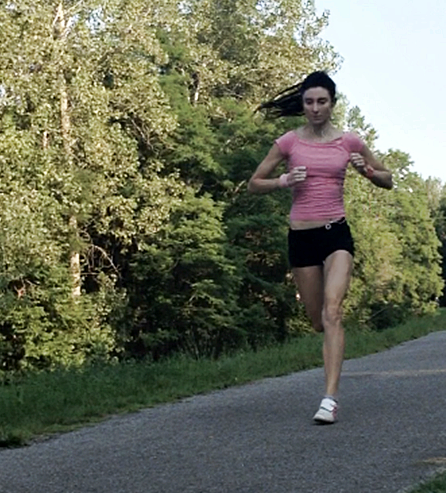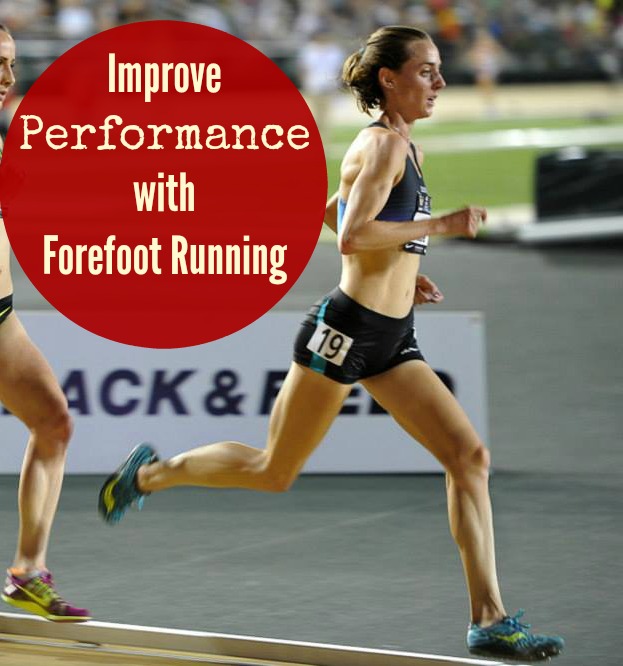From a mechanical and an injury prevention perspective, does forefoot running improve performance? Yes it does and it’s all thanks to how forefoot running saves more elastic energy and reduces the impact transient as compared with heel strike running.
Improve Performance with Forefoot Running

Let’s look at in detail the energy-saving mechanisms of a forefoot running style:
- less muscular effort required due to forward shifting weight transfer
- more knee bend (greater knee flexion) coupled with ankle plantarflexion at touchdown, allows more elastic energy storage in the Achilles tendon.
- reduced stride-length, therefore no braking.
- less vertical mechanical oscillation and more elastic oscillation, lowering energy demands
Elastic Bounce
Heel strike runners and forefoot runners bounce when they run, but the nature of the bounce differs between the two style of running.
Running with a bounce (vertical oscillation) comes in two forms: mechanical bouncing which pertains to heel strike running and elastic bouncing which pertains to forefoot running.
New studies suggests mechanical bouncing (i.e. heel strike running) is less efficient because more negative work from the leg muscles is needed to propel the body forward.
In contrast, forefoot runners have an elastic bounce due to a forward lean, high knee flexion and ankle plantarflexion.
- The forward lean keeps the mass of the body on top, or close to the balls of the foot at touchdown.
- At touchdown, the knee bends and the Achilles tendon compresses like a spring. Why? Because the mass of the body compresses the Achilles tendon.
- When the mass of the body moves more forward, because remember, the torso is always travelling forward via leaning, the foot pops off the ground. This is an elastic bounce.
Thus, the main difference between elastic and mechanical bouncing in running is that an elastic bounce uses more elastic strain energy stored in the tendons instead of muscular power.
Gravity and Forward Momentum
Another reason forefoot running boosts running economy is by not fighting the force of gravity like heel strike runners tend to do by running too up-right.
In forefoot running, the entire body is continuously falling. According to Pose Running, when the foot strikes the ground under the knee, not in front, it is quickly removed from the ground by the spring-action of the leg.
In contrast, gravity works against heel strike runners because they don’t lean forward and as a consequence, the legs are required to pull the center of mass along the way.
A continuous body-fall in forefoot running utilizes more spring energy from the tendons of the hind leg and not from the muscles thereby forefoot running is indicative of less muscular demands than heel strike running.
Less Injuries = More Time to Train
As mentioned above, forefoot runners do not use their lower leg muscles the same as heel strikers. Forefoot runners rely more on gravitational forces to propel the body forward such as at each step, the legs ‘get-out-of-the-way’ and swing rearward behind the body.
Conversely, heel strikers work against gravity to propel their body forward. Heel strikers launch their body with their forefoot and toes which not only increases muscular work, but may strain the toes, or the Achilles tendon, possibly leading to injury, and injury means more time injured.
Consistent training is key for improving endurance capacity. Forefoot runners may experience fewer injuries, which may allow an advantage over heel strikers who are frequently injured, to train on a consistent basis. Another key thing to remember is running faster in forefoot running will maximum energy elastic energy storage.
More on the Health Benefits of Forefoot Running:
- Reduces Plantar Fasciitis Symptoms
- Eliminates Shin Splints
- Attenuates Impact Better than Heel Striking
- Less Jolt on the Body
- Less Pronation
References:
Ardigo et al., Metabolic and mechanical aspects of foot landing type, forefoot and rearfoot strike, in human running. Act Physiol, 1995; 155(1):17-22.
Goss, DL and Gross, MT. A review of mechanics and injury trends among various running styles. US Army Med Dep J, 2012; 67-71.
Bretta Riches
BSc Neurobiology; MSc Biomechanics candidate, ultra minimalist runner & founder of RunForefoot. I was a heel striker, always injured. I was inspired by the great Tirunesh Dibaba to try forefoot running. Now, I'm injury free. This is why I launched Run Forefoot, to advocate the health & performance benefits of forefoot running and to raise awareness on the dangers of heel striking, because the world needs to know.
Latest posts by Bretta Riches (see all)
- Heel Lifts Increase Injury in Runners - 16/04/2024
- Are Minimalist Shoes Good for Seniors? YES! - 14/04/2024
- BIG Deals On Running Gear And More! - 09/04/2024


Leave a Reply